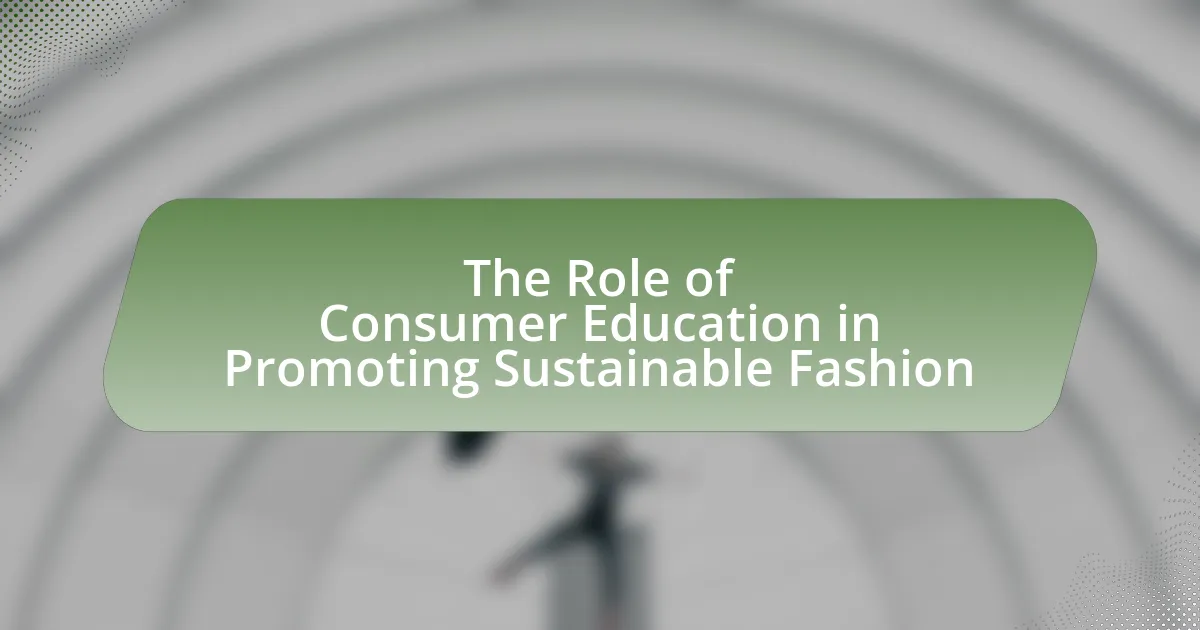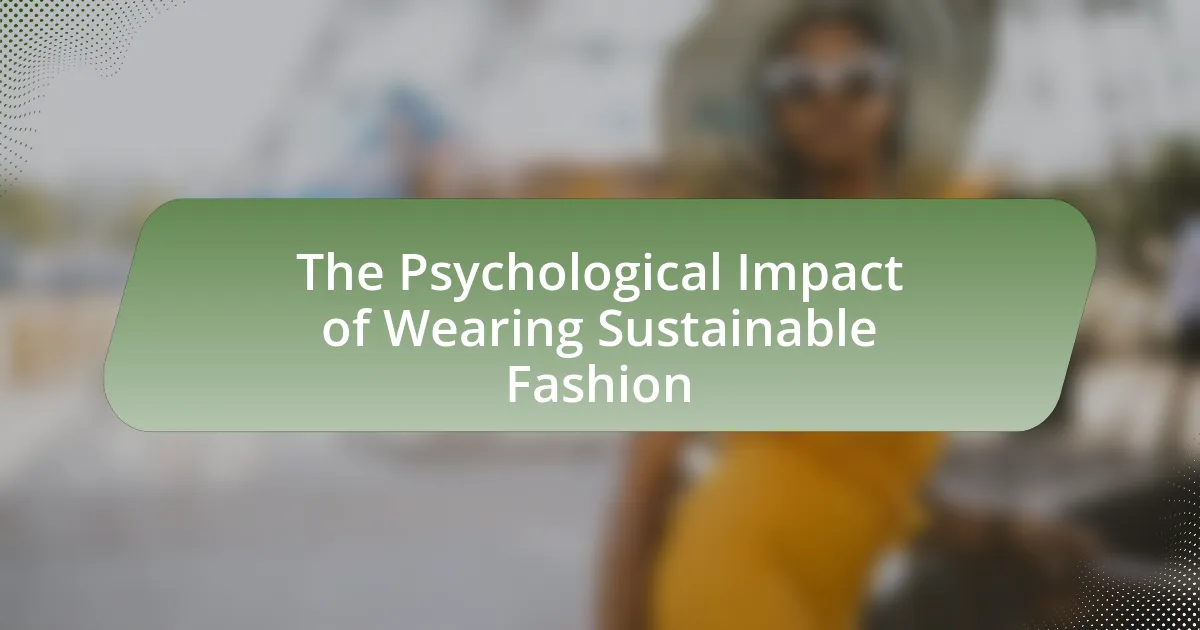Building a sustainable fashion brand involves creating a clothing line that emphasizes environmental and social responsibility throughout its lifecycle. This article explores the importance of sustainability in the fashion industry, highlighting the environmental impacts of traditional practices and the role of consumer awareness in driving demand for ethical products. It outlines key principles of sustainable fashion, including ethical production, resource efficiency, and circularity, while addressing the challenges entrepreneurs face, such as high production costs and supply chain transparency. Additionally, the article discusses innovative solutions and strategies for promoting sustainability, including the use of technology, partnerships, and effective communication to enhance brand visibility and consumer engagement.

What does it mean to build a sustainable fashion brand?
Building a sustainable fashion brand means creating a clothing line that prioritizes environmental and social responsibility throughout its entire lifecycle. This involves using eco-friendly materials, implementing ethical labor practices, and minimizing waste through recycling and upcycling. According to the Global Fashion Agenda’s 2021 report, the fashion industry is responsible for 10% of global carbon emissions, highlighting the urgent need for sustainable practices. By adopting these principles, brands can contribute to reducing their ecological footprint and promoting fair labor conditions, thereby aligning with consumer demand for transparency and sustainability in fashion.
Why is sustainability important in the fashion industry?
Sustainability is important in the fashion industry because it addresses environmental degradation, social inequality, and economic viability. The fashion industry is one of the largest polluters globally, contributing to 10% of annual carbon emissions and consuming vast amounts of water and resources. By adopting sustainable practices, brands can reduce waste, lower their carbon footprint, and promote ethical labor practices, which are essential for long-term viability and consumer trust. Studies show that 66% of consumers are willing to pay more for sustainable brands, indicating a market shift towards eco-friendly products.
What are the environmental impacts of traditional fashion practices?
Traditional fashion practices significantly contribute to environmental degradation through resource depletion, pollution, and waste generation. The fashion industry is responsible for 10% of global carbon emissions, primarily due to the energy-intensive processes involved in textile production and garment manufacturing. Additionally, conventional dyeing processes often utilize toxic chemicals, which can contaminate water sources and harm aquatic ecosystems. Furthermore, the fast fashion model encourages overconsumption, leading to approximately 92 million tons of textile waste generated annually, much of which ends up in landfills. These practices not only strain natural resources but also exacerbate climate change and biodiversity loss, highlighting the urgent need for sustainable alternatives in the fashion industry.
How does consumer awareness influence sustainable fashion?
Consumer awareness significantly influences sustainable fashion by driving demand for ethically produced and environmentally friendly products. When consumers are informed about the negative impacts of fast fashion, such as pollution and labor exploitation, they are more likely to support brands that prioritize sustainability. Research indicates that 66% of global consumers are willing to pay more for sustainable brands, highlighting the economic impact of consumer awareness on the fashion industry. This shift in consumer behavior encourages brands to adopt sustainable practices, thereby promoting a more responsible fashion ecosystem.
What are the key principles of sustainable fashion?
The key principles of sustainable fashion include ethical production, resource efficiency, and circularity. Ethical production emphasizes fair labor practices and humane working conditions, ensuring that workers are treated with respect and compensated fairly. Resource efficiency focuses on minimizing waste and utilizing sustainable materials, such as organic cotton or recycled fabrics, to reduce environmental impact. Circularity promotes the idea of designing products for longevity and recyclability, encouraging consumers to recycle or upcycle garments rather than discarding them. These principles collectively aim to create a fashion industry that is environmentally responsible and socially equitable.
How do ethical sourcing and production contribute to sustainability?
Ethical sourcing and production significantly contribute to sustainability by ensuring that materials are obtained and products are made in ways that minimize environmental impact and promote social responsibility. This approach reduces waste, conserves resources, and supports fair labor practices, which collectively enhance the overall sustainability of the fashion industry. For instance, according to the Global Fashion Agenda’s 2020 report, sustainable practices can reduce greenhouse gas emissions by up to 30% in the fashion sector. By prioritizing ethical sourcing, brands can also foster biodiversity and protect ecosystems, as seen in initiatives that promote organic cotton farming, which uses less water and avoids harmful pesticides.
What role does circular fashion play in sustainability?
Circular fashion plays a crucial role in sustainability by promoting the reuse, recycling, and upcycling of materials, which significantly reduces waste and resource consumption. This approach minimizes the environmental impact of the fashion industry, which is responsible for approximately 10% of global carbon emissions and a significant amount of water pollution. By extending the lifecycle of garments and materials, circular fashion helps to create a closed-loop system that conserves resources and reduces the need for new raw materials, thereby supporting sustainable practices in the industry.

What challenges do entrepreneurs face when building a sustainable fashion brand?
Entrepreneurs face several challenges when building a sustainable fashion brand, including sourcing eco-friendly materials, managing supply chain transparency, and navigating consumer skepticism. Sourcing eco-friendly materials can be difficult due to limited availability and higher costs compared to conventional fabrics. Managing supply chain transparency is essential for ensuring ethical practices, yet it often involves complex logistics and partnerships with various stakeholders. Additionally, consumer skepticism about the authenticity of sustainability claims can hinder brand trust and market acceptance. According to a 2021 McKinsey report, 66% of consumers are willing to pay more for sustainable brands, but they also demand proof of sustainability efforts, highlighting the importance of transparency and credibility in overcoming these challenges.
What are the financial barriers to starting a sustainable fashion brand?
The financial barriers to starting a sustainable fashion brand include high initial capital requirements, increased production costs, and limited access to funding. High initial capital is necessary for sourcing sustainable materials, which often cost more than conventional options; for example, organic cotton can be 20-30% more expensive than regular cotton. Increased production costs arise from ethical labor practices and sustainable manufacturing processes, which can lead to higher prices for consumers. Additionally, limited access to funding is a significant barrier, as many investors may prioritize traditional fashion models over sustainable ones, making it challenging for new brands to secure necessary financial backing.
How can high production costs affect pricing strategies?
High production costs can lead to increased prices for products, as businesses must cover their expenses to maintain profitability. When production costs rise due to factors such as sustainable materials or ethical labor practices, brands often adjust their pricing strategies to reflect these higher costs. For instance, a study by McKinsey & Company indicates that sustainable fashion brands typically charge 20-30% more than conventional brands to account for the investment in ethical production methods. This adjustment in pricing can also influence consumer perception, positioning the brand as premium or luxury, which may attract a specific market segment willing to pay more for sustainability.
What funding options are available for sustainable fashion startups?
Sustainable fashion startups can access various funding options, including venture capital, crowdfunding, grants, and impact investing. Venture capital firms increasingly focus on sustainable businesses, providing significant capital in exchange for equity. Crowdfunding platforms like Kickstarter and Indiegogo allow startups to raise funds directly from consumers who support their mission. Additionally, numerous grants are available from government programs and non-profit organizations aimed at promoting sustainability in fashion. Impact investing focuses on generating social and environmental benefits alongside financial returns, attracting investors interested in sustainable practices. These funding avenues are essential for sustainable fashion startups to scale their operations and innovate in eco-friendly practices.
What operational challenges arise in sustainable fashion?
Operational challenges in sustainable fashion include sourcing sustainable materials, managing supply chain transparency, and ensuring ethical labor practices. Sourcing sustainable materials often involves higher costs and limited availability, which can hinder production efficiency. Managing supply chain transparency is complicated due to the need for traceability and accountability at every stage, making it difficult to verify sustainable practices. Additionally, ensuring ethical labor practices requires rigorous monitoring and compliance, which can strain resources and increase operational complexity. These challenges are supported by industry reports indicating that 66% of consumers expect brands to be transparent about their supply chains, highlighting the importance of addressing these operational hurdles.
How can supply chain transparency be achieved?
Supply chain transparency can be achieved through the implementation of traceability technologies, such as blockchain, which allows for real-time tracking of products from origin to consumer. By utilizing these technologies, companies can provide verifiable information about sourcing, production processes, and labor conditions. For instance, a study by the World Economic Forum highlights that blockchain can enhance transparency by creating immutable records that stakeholders can access, thereby fostering trust and accountability in the supply chain.
What logistical issues do sustainable brands encounter?
Sustainable brands encounter logistical issues primarily related to sourcing eco-friendly materials and managing supply chains. These brands often struggle with limited availability of sustainable raw materials, which can lead to higher costs and longer lead times. For instance, organic cotton and recycled fabrics are not as widely produced as conventional materials, making them harder to source consistently. Additionally, sustainable brands face challenges in ensuring that their entire supply chain adheres to ethical and environmental standards, which can complicate logistics and increase operational complexity. According to a report by McKinsey & Company, 66% of fashion executives believe that supply chain transparency is a significant challenge for sustainable brands, highlighting the difficulties in tracking and verifying sustainable practices throughout the production process.

What solutions exist to overcome challenges in building a sustainable fashion brand?
Solutions to overcome challenges in building a sustainable fashion brand include adopting eco-friendly materials, implementing transparent supply chains, and utilizing technology for efficiency. Eco-friendly materials, such as organic cotton and recycled fabrics, reduce environmental impact and appeal to conscious consumers. Transparent supply chains foster trust and accountability, allowing brands to showcase ethical practices and sourcing. Additionally, technology, including digital design tools and sustainable production methods, enhances efficiency and minimizes waste. According to a report by McKinsey & Company, brands that prioritize sustainability can improve their market position and attract a growing demographic of environmentally aware consumers.
How can technology aid in creating sustainable fashion solutions?
Technology can aid in creating sustainable fashion solutions by enabling efficient resource management and reducing waste through innovative practices. For instance, digital tools like 3D modeling and virtual fitting rooms minimize fabric waste by allowing designers to prototype and test garments digitally before production. Additionally, blockchain technology enhances transparency in supply chains, ensuring ethical sourcing of materials and fair labor practices. According to a report by McKinsey & Company, implementing advanced technologies in fashion can reduce greenhouse gas emissions by up to 30% by 2030. This demonstrates that technology not only streamlines production processes but also significantly contributes to sustainability in the fashion industry.
What innovations are leading the way in sustainable materials?
Innovations leading the way in sustainable materials include bio-based textiles, recycled fibers, and innovative manufacturing processes. Bio-based textiles, such as those made from organic cotton or hemp, reduce reliance on petroleum-based materials and lower environmental impact. Recycled fibers, like those derived from post-consumer plastic bottles, significantly decrease waste and resource consumption; for instance, using recycled polyester can save up to 60% energy compared to virgin polyester production. Additionally, advancements in manufacturing processes, such as waterless dyeing technologies, minimize water usage and pollution, further enhancing sustainability in the fashion industry. These innovations collectively contribute to a more sustainable approach in material sourcing and production within the fashion sector.
How can digital platforms enhance brand visibility and consumer engagement?
Digital platforms enhance brand visibility and consumer engagement by providing targeted advertising, interactive content, and real-time communication. These platforms allow brands to reach specific demographics through data-driven marketing strategies, increasing the likelihood of engagement. For instance, social media platforms like Instagram and Facebook enable brands to showcase their products visually, which is particularly effective in the fashion industry, where aesthetics play a crucial role. According to a report by Hootsuite, 54% of consumers use social media to research products, highlighting the importance of maintaining a strong online presence. Additionally, features such as live chats and customer feedback options foster direct interaction, allowing brands to build relationships with consumers and respond to their needs promptly. This two-way communication not only enhances engagement but also builds brand loyalty, as consumers feel valued and heard.
What strategies can brands implement to promote sustainability?
Brands can implement several strategies to promote sustainability, including adopting eco-friendly materials, optimizing supply chains, and engaging in transparent communication with consumers. By using organic, recycled, or biodegradable materials, brands can significantly reduce their environmental impact. For instance, a study by McKinsey & Company found that sustainable materials can lower greenhouse gas emissions by up to 30%. Additionally, optimizing supply chains through local sourcing and efficient logistics can minimize carbon footprints. Brands like Patagonia exemplify this by prioritizing local production and fair labor practices. Lastly, transparent communication about sustainability efforts fosters consumer trust and loyalty, as evidenced by a Nielsen report indicating that 66% of global consumers are willing to pay more for sustainable brands.
How can storytelling be used to connect with consumers?
Storytelling can be used to connect with consumers by creating emotional resonance and relatability through narratives that reflect shared values and experiences. For instance, brands that share their journey towards sustainability, including challenges faced and milestones achieved, foster a sense of authenticity and trust. Research indicates that 55% of consumers are more likely to purchase from brands that tell compelling stories, as these narratives help consumers feel a personal connection to the brand’s mission and values. This connection can lead to increased brand loyalty and advocacy, as consumers are more inclined to support brands that align with their own beliefs and lifestyles.
What partnerships can enhance sustainability efforts?
Collaborations between fashion brands and environmental organizations can significantly enhance sustainability efforts. For instance, partnerships with NGOs focused on conservation can lead to initiatives that promote sustainable sourcing of materials, reducing environmental impact. A notable example is the collaboration between Stella McCartney and the World Wildlife Fund, which aims to promote sustainable practices in the fashion industry. Such partnerships not only provide expertise and resources but also enhance brand credibility and consumer trust, as evidenced by studies showing that consumers are more likely to support brands engaged in sustainability initiatives.
What best practices should be followed when building a sustainable fashion brand?
To build a sustainable fashion brand, prioritize ethical sourcing, transparency, and eco-friendly materials. Ethical sourcing ensures that raw materials are obtained from suppliers who adhere to fair labor practices and environmental standards. Transparency involves openly sharing information about the supply chain, allowing consumers to understand the brand’s impact on the environment and society. Utilizing eco-friendly materials, such as organic cotton or recycled fabrics, reduces environmental harm and promotes sustainability. According to the Global Fashion Agenda’s 2021 report, brands that adopt sustainable practices can significantly reduce their carbon footprint and resource consumption, demonstrating the effectiveness of these best practices in fostering a responsible fashion industry.
How can brands effectively communicate their sustainability efforts to consumers?
Brands can effectively communicate their sustainability efforts to consumers by utilizing transparent messaging and engaging storytelling. Transparency involves providing clear, accessible information about sustainable practices, such as sourcing materials, production processes, and environmental impact. For instance, brands like Patagonia openly share their supply chain details and sustainability reports, which builds trust with consumers. Engaging storytelling can illustrate the brand’s commitment to sustainability through relatable narratives, showcasing real-life impacts and community involvement. Research indicates that 66% of consumers are willing to pay more for sustainable brands, highlighting the importance of effective communication in influencing purchasing decisions.
What metrics should be used to measure sustainability success?
To measure sustainability success, key metrics include carbon footprint, water usage, waste reduction, and social impact. Carbon footprint quantifies greenhouse gas emissions, providing insight into environmental impact; for instance, the Global Carbon Project reported that global CO2 emissions reached 36.4 billion tons in 2019, highlighting the need for reduction efforts. Water usage metrics assess the volume of water consumed in production processes, with the fashion industry being responsible for 20% of global wastewater, according to the UN. Waste reduction metrics track the amount of waste diverted from landfills, with a goal of achieving zero waste in production. Lastly, social impact metrics evaluate labor practices and community engagement, with the Ethical Trading Initiative emphasizing the importance of fair labor conditions in sustainable practices. These metrics collectively provide a comprehensive framework for assessing sustainability in the fashion industry.




